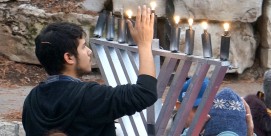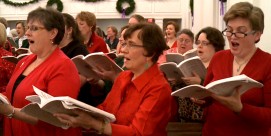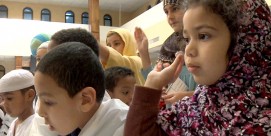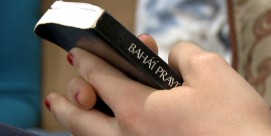REV. KENNETH SEMON (The Church of the Holy Faith, Sante Fe, NM): I try to tell people—don’t just come on Sunday, you know, you’ll miss it. You’ll miss everything that this means and all that leads up to it.
They’re called the three solemn days. To go through the experience of the three days is really to go through what changes life for people. And it starts Maundy Thursday with the washing of the feet and the last supper and Jesus’ institution of the Holy Eucharist.
REV. ROCKY SCHUSTER (Episcopal Priest, Taos, NM): Jesus gives the new commandment—love one another as I have loved you, as opposed to as you would have others love you. You serve one another, you feed one another, you take care of one another, even to the point of death. And in the process of doing that, you’ll find new life, you’ll get the Easter experience, you’ll discover what eternal life is really all about.
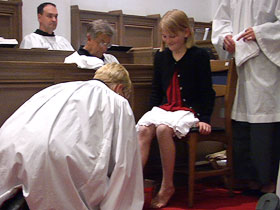
REV. SEMON: I must tell you, it’s so humbling to wash people’s feet. I cannot tell you what an experience that is, and what a privilege it is really. In Jesus’ day they weren’t necessarily wearing shoes and, in fact, a servant could not be compelled to wash someone’s feet. So you see, it’s even more of an expression of service and humility before your fellows.
We dress in white, so it’s a great change from the purple we’ve been wearing, or the red we’ve worn, throughout Holy Week. When the service is over, after everyone has received communion, we will process into the “Garden of Gethsemane,” which is in our chapel. Jesus says, “Could you watch with me but an hour?” He says that to his disciples. And so people will sit there throughout the night, in prayer of course, silence.
REV. SCHUSTER: We know that he leaves the last supper, he goes and prays, and is captured and taken to trial.
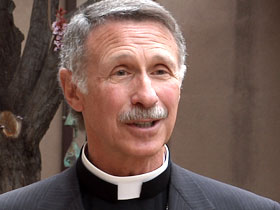 Rev. Kenneth Semon
Rev. Kenneth SemonREV. SEMON: At the end of the service, instead of the final blessing, we strip the altar. We pull everything out of the sanctuary, everything with color. And all the while we are stripping the altar, the choir will be chanting a Psalm of, you know, this is very serious…life is coming to an end.
REV. SCHUSTER: You get the imagery of Jesus being stripped of his clothing and whipped and the rest of the starkness, of the rest of the story.
REV. SEMON: The lights go off. You feel the darkness descend over the Earth, you really do.
REV. SCHUSTER: Good Friday is the ultimate act of loving us. It is the crucifixion, it is taking the suffering that he took under arrest, it is the dying. And so doing these physical things, and acts of contrition, make a lot of sense to people on Good Friday.
REV. SEMON: Pilgrimage becomes a metaphor for life, you know, we’re going to the Holy Place, following our Lord who goes before us. And the tradition here is to go to Chimayo, to this wonderful little place, the Santuario. There’s a tradition that the earth, the dirt in the sacristy, has healing powers. And so it’s a sort of sacred site.
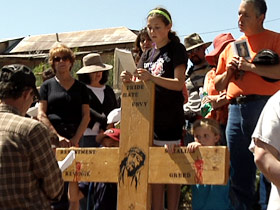
ELIZABETH FRIARY: This is the most religious thing that I do every year because it just feels really holy. And I suppose I could walk it by myself any other time of year, but it wouldn’t be with this crowd.
DONNA LUCERO: We’re going to be tired. We’re going to be very exhausted by the end of the day. But, you know, Jesus did this for us and so we got to give a little bit back, as much as we can. So it is kind of very spiritually uplifting.
REV. SCHUSTER: That physical participation adds an extra dimension. It’s not just sitting in a pew or standing or kneeling. That actual physical activity puts it into your body, so you feel it.
JOSE MIGUEL PACHECO: You’re physically exhausted, you have blisters. And I mean you’re just worn out. And it just gives you such a tiny little taste of what Jesus had to endure for us.
REV. SCHUSTER: When you come to Easter Sunday, our desire is to not just give thanks for what happened two thousand years ago but, in truth, to comprehend the new life that the resurrection brings to all of us. That when we love one another as Christ loved us, we actually get to live that resurrected life. And to take that out with us when we leave here—not just to serve one another but to serve everybody we encounter. That whole service represents the joy we can have in the world…the rest of the world…the rest of the time.




